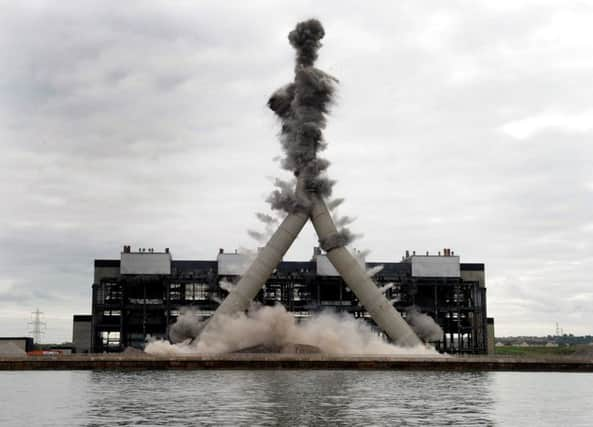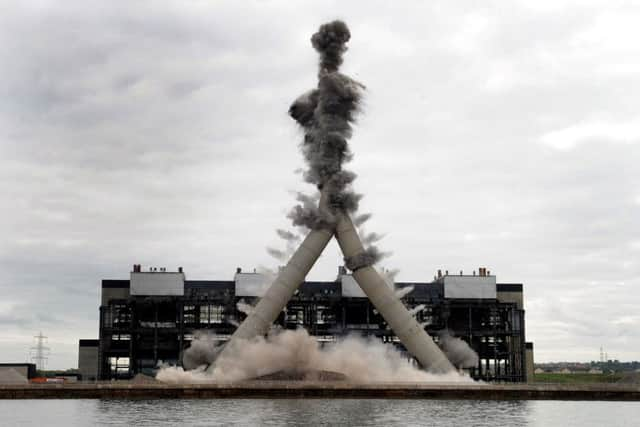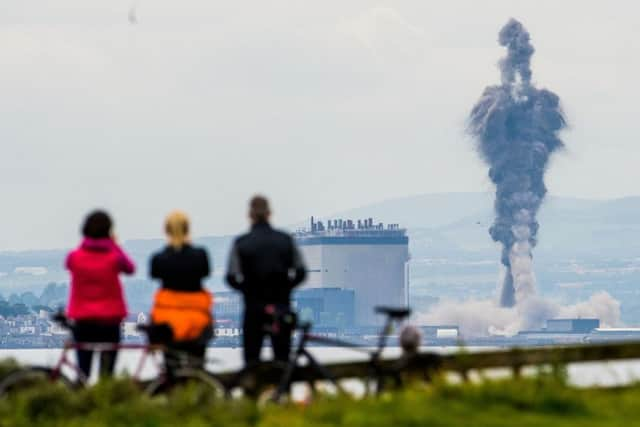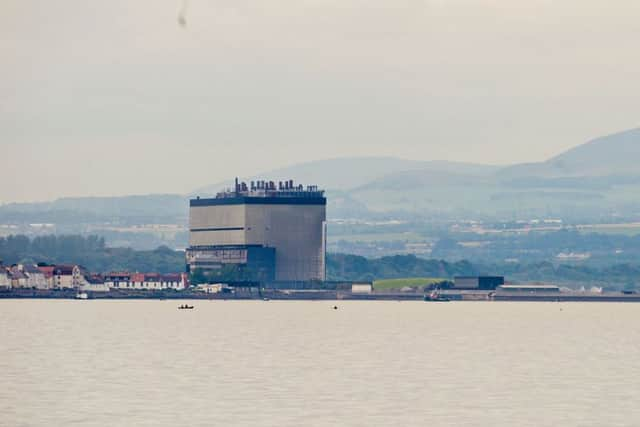Cockenzie Power Station towers demolished


The demolition of the East Lothian landmark was watched by thousands gathered at nearby vantage points and on board a flotilla of small boats in the Firth of Forth.
In a matter of seconds the chimneys of the former coal-powered power station, which opened in 1967, collapsed, leaving behind billowing clouds of smoke. When the smoke cleared the famous skyline had changed forever.
Advertisement
Hide AdAdvertisement
Hide AdFor those watching, the disappearance of the towers brought mixed emotions. Some professed to be glad to see the destruction of an industrial eyesore. Others wiped away tears as the 149 metre stacks swayed towards one another and collided on the way down.


A second explosion immediately after brought down the ScottishPower-owned station’s turbine hall. The boiler house, Cockenzie’s last remaining structure, is scheduled for demolition later this year.
Preparations for yesterday’s controlled explosion were meticulous. Each of the chimney stacks had 150 holes drilled in it, which were then filled with 150kg of explosives. The explosives were designed to blow out the base of the chimneys so they fell towards each other, sending debris 140 metres into the air.
An exclusion zone around the power station, which was decommissioned in March 2013, was put in place at 9am to ensure the operation was carried out safely.
The demolition of both chimneys was initiated by East Lothian resident Donald McCulloch, who won a charity raffle organised by Longniddry and District Rotary Club to press the start button.


The twin chimney stacks were constructed for the coal station opening in 1967, then the largest power station in Scotland.
The facility generated more than 150 terawatt hours of electricity in its lifetime, enough to power the average annual electricity needs of more than a million homes every year, until it closed two years ago.
Hugh Finlay, ScottishPower generation director, said: “The demolition team have been working towards this day for two years, and it was fantastic to see all of our detailed preparations and calculations culminate in such a dramatic event.”
Advertisement
Hide AdAdvertisement
Hide AdIn total, it is estimated that more than 10,000 people have been employed at Cockenzie, during construction and operation, with many thousands of other jobs supported in the wider supply chain and local area.


Environmentalists said the demolition marked a positive step forward in fighting climate change.
Dr Richard Dixon, director of Friends of the Earth Scotland, said: “The demolition of the iconic Cockenzie chimneys will dramatically change the Lothians landscape and signals the imminent end for coal in Scotland.
“For those who’ve worked at the plant it may well be an emotional day but as a country it shows the positive steps we’ve taken in the fight against climate change and for clean energy.”
Cockenzie Power Station was officially opened on May 24, 1968, by the Secretary of State for Scotland, William Ross.
At the time, Britain was still two years away from natural gas being used in electricity generation. Coal accounted for approximately 72 per cent of the fuel input used for electricity generation in Britain, compared to approximately 20.5 per cent in 2014.
In an average year the station would receive approximately 800 train loads of coal, meaning that up to 36,000 freight trains stopped at Cockenzie’s coal handling plant to make deliveries over the lifetime of the station. The last delivery took place on March 9.
Designed by Sir Robert Matthew, who also designed Edinburgh Airport and the Royal Commonwealth Pool, and best known for its distinctive twin chimney stacks, the station was built with a generating capacity of 1,200MW, and was made up of our identical units, each capable of generating 300MW. Due to strategic investment and high levels of maintenance, the station comfortably outlived its original estimates of a 25-30 year life cycle.
Advertisement
Hide AdAdvertisement
Hide AdCockenzie Power Station, set amid East Lothian’s rolling farmland, occupied a 93 hectare site on the south shore of the Forth Estuary.
The grounds of Cockenzie Power Station, especially its ash settling lagoons, provide a range of habitats for local wildlife, including woodland, meadows and wetlands.
The 120-hectare ash lagoons in Musselburgh are also widely recognised as one of the best places to watch birds in Scotland.
In particular, specially constructed wader scrapes – shallow freshwater pools lined with clay built on a decommissioned area – have been included within the Firth of Forth Site of Special Scientific Interest (SSSI) in recognition of their value to birds.
The station has supported a wide variety of community events and projects in its lifetime, including the 3Harbours Arts Festival.